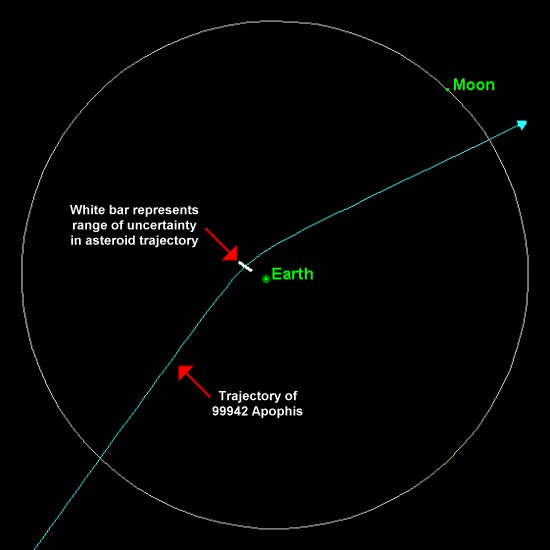So called ‘doomsday asteroid’ Apophis much larger than previously thought

Projected trajectory of Apophis in 2029. Before Apophis buzzes Earth in 2029, or 2036, it will streak by planet Earth on January 10, 2013. Scientists hope to get a better idea of the size and the dimensions of the asteroid in case they have to deflect it.
January 10, 2013 – SPACE – Astronomers following the so-called doomsday asteroid Apophis, which will be whizzing past Earth on Thursday morning, have found the rock is much larger than had previously been assumed. Since the asteroid could hit Earth in 2036, that’s a problem. The asteroid, named after an Egyptian god of death, had been thought to be around 885 feet (270 meters) wide, plus or minus a couple of hundred feet (60 meters). But as Apophis approached last weekend, astronomers at the Herschel Space Observatory took new observations and have concluded that astronomers have seriously underestimated both its size and its mass.
“The 20 per cent increase in diameter, from 270 to 325m, translates into a 75 per cent increase in our estimates of the asteroid’s volume or mass,” said Thomas Müller of the Max Planck Institute for Extraterrestrial Physics in Garching, Germany. “These numbers are first estimates based on the Herschel measurements alone, and other ongoing ground-based campaigns might produce additional pieces of information which will allow us to improve our results.”
In addition, the asteroid has a much different reflectivity, or albedo, than previously thought; 0.23 rather than the previous estimates of 0.33. This changes astronomer’s calculations of the Yarkovsky effect, or how the Sun’s heating and cooling influence will alter the asteroid’s progress in orbit. Apophis caused alarm on Christmas Eve 2004 after a report that it had a 2.7 per cent chance of hitting Earth in 2029, and even if it missed, the encounter could set it up for another strike in 2036. The asteroid topped the Torino Scale of risk, briefly reaching level four out of 10 – where zero is no threat and 10 is WE’RE DOOMED!)
After checking the data and weeding out the false reports, Apophis was downgraded to a level one threat and is currently expected to whizz past on Friday, April 13, 2029 at a distance of about 36,000 miles, just inside the orbit of our geostationary satellites.
Some argue that asteroid will come closer. According to Universe Today, “the asteroid is expected to make a record-setting — but harmless — close approach to Earth on Friday, April 13, 2029, when it comes no closer than 18,300 miles above Earth’s surface.”
There’s a kicker. If the asteroid passes through a gravitational zone, it will perturb its progress just enough to make sure that it will most likely hit the Earth on April 13, 2036.
According to Neil deGrasse Tyson, geek icon and director of the Hayden Planetarium, if it passes through the center of the gravitational “keyhole” it’ll hit the Pacific off Santa Monica, California and “sandblast the Western seaboard” with the resulting wave of tsunamis.
The asteroid is making a relatively close appearance past Earth on Thursday, coming within nine million miles of us at 1am UTC (5pm Wednesday PST) and it’s being shown live on the Virtual Telescope Project. NASA and other space agencies are watching it closely to check on the current state of play with the asteroid’s orbit as it enters and leaves Earth’s orbit.
The odds of a 2036 impact are still tiny – an estimated 1 in 250,000 – but human ingenuity being what it is, there are already fertile minds working on a plan to deflect the asteroid. A recent Australian scheme called for paintballs to be fired at Apophis to increase the Yarkovsky effect and swing it out of harm’s way, and solar sails have been mooted. –Register
